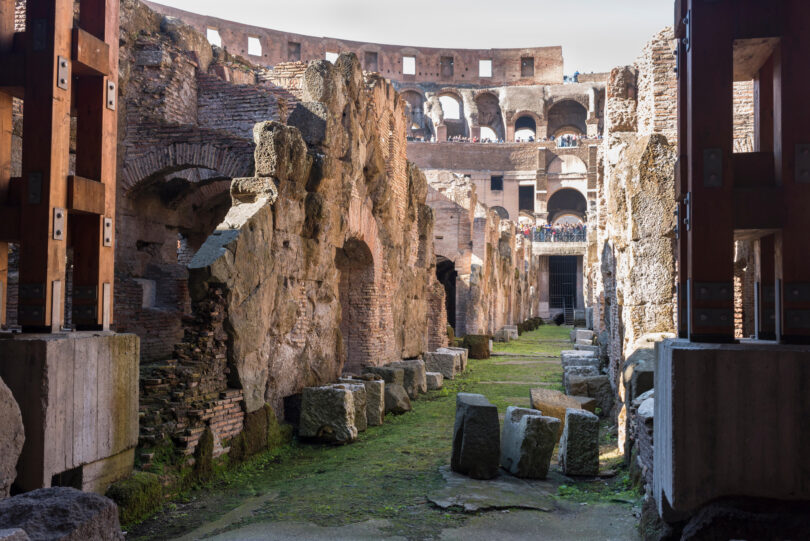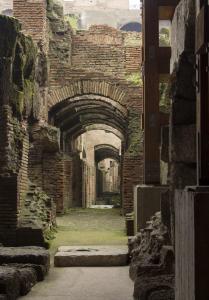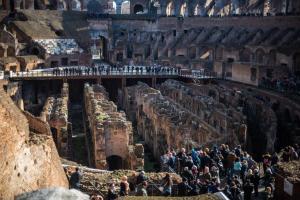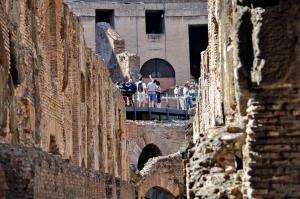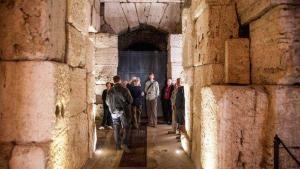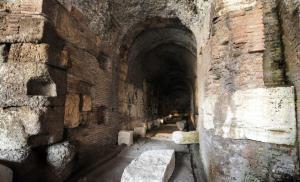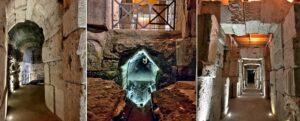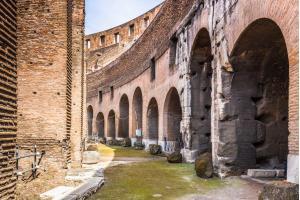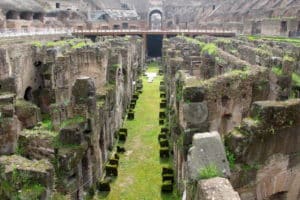Colosseum Underground Tour has outstanding stories & sights of the Ancient world. In ancient Rome, thousands of people watched the battle of slaves, convicted criminals, and wild animals in a large amphitheater known as the Colosseum. Under the wooden Colosseum floor, which was the scene of many gladiator events and wild animal hunting, was a completely different world.
To make these eerie displays possible, Roman architects designed a series of intricate and interconnected tunnels beneath the floor of the Colosseum arena: Underground of Colosseum. You can find everything you are looking for in our article about the underground tunnels of the Colosseum which you can visit with a guide today.
If you are looking for a detailed Colosseum visit and are planning to take a tour, we highly recommend choosing a tour that includes visiting the Colosseum’s underground. In the Colosseum Underground Tour, visitors have access to special areas with skip-the-line access, not open to standard entry-ticket holders.
So how can you visit the Colosseum underground? What are the official tickets and tours? What are the best and most comprehensive tours? The answers to all questions are in this article. Let’s get started!
Book Colosseum Underground Tours & Tickets:
The magnificence of the Colosseum, a timeless emblem of Rome, beckons travelers from across the globe, making it imperative to secure your tickets well ahead of your visit. However, obtaining tickets to explore this architectural marvel can be a bit of a labyrinth.
The chance to delve into the Colosseum’s underground and arena is particularly rare, with only a select number of visitors allowed entry. For July 2024, official tickets to these exclusive sections are priced at 24 Euros for a basic underground visit, which only includes access to the Colosseum’s subterranean levels and the main arena. This visit is facilitated by an official guide, ensuring an enriching experience. Moreover, the Colosseum authorities organize a special 75-minute “Didactic Visit” in English, Italian, and Spanish, which includes a comprehensive tour of the Colosseum’s interior, arena, and the intriguing underground tunnels, narrated by knowledgeable Colosseum staff, priced at 32 Euros.
Tickets for the official tour are usually available in the winter months, but during the high season (April to October), it is almost impossible to find tickets. Beyond the official tours, various operators offer extensive Colosseum tours that encompass not only the underground and arena but also the Roman Forum and Palatine Hill, providing a fuller picture of ancient Roman life. These tours vary in price depending on the size of the group (eg private group, group of 10 or group of 30 people) and the date and time of the visit. Our website diligently compares hundreds of these options**, focusing on those with high customer satisfaction and positive reviews, ensuring you make the most informed choice for your visit.
**Tour prices are checked and updated everyday. You can click on the reservation link for short-term opportunities and more details. You can send us an e-mail for your tour suggestions, we will be happy to publish them.
Update for today: As of 26.07.2024 all official tickets (underground tickets and underground tour tickets) are sold out.
from €24.00 EUR
Closest Date: All tickets are sold out
Validity: 2 Days
Seller: Parco archeologico del Colosseo
from €32.00 EUR
Closest Date: All tickets are sold out
Duration: 1 h. 15 Min.
Seller: Parco archeologico del Colosseo
from €127.09 EUR
Duration: 75 minutes
Organized by: Discover Rome Tours
187 Reviews
from €69.50 EUR
Duration: 3 Hours
Organized by: The Ultimate Italy
3.258 Reviews
from €75.00 EUR (Approx.)
Duration: 3 Hours
Organized by: Tours of Rome SRLS
866 Reviews
from €60.00 EUR
Validity: 2 Days
Organized by: Touristation Rome
57 Reviews
from €119.00 EUR (Approx.)
Duration: 3 Hours
Organized by: Italy With Family
766 Reviews
from €109.00 EUR
Duration: 2 hours
Organized by: Italy With Family
1.393 Reviews
from €74.50 EUR
Duration: 75 Minutes – 3 Hours
Organized by: The Ultimate Italy
2.552 Reviews
from €159.00 EUR
Duration: 3 Hours
Max group size: Limited to 6 participants
Organized by: Eyes of Rome Private Tours
340 Reviews
from €320.00 EUR
Duration: 3 hours
Organized by: Eyes of Rome Private Tours
29 Reviews
Visiting the Underground by Night
If you don’t want to visit the Colosseum in the heat of the day and you want to visit it away from the busy crowds, you can visit the Colosseum at night. Visiting the Colosseum at night doesn’t mean you’ll see it in total darkness. You will not miss the details thanks to the special lightings and the explanations of your tour guide. Also, a night visit will give you a different perspective and atmosphere. However, underground night tours do not have the option to visit the Roman Forum and Palatine Hill. The Roman Forum and Palatine Hill can only be visited at night for special events.
Meet outside the famous landmark and start the Colosseum night tour after a quick introduction. Walk through the Gate of Death, the exit for perished gladiators, and get get VIP access to the arena floor. While standing on the arena floor, stare up at the night sky through Colosseum’s open-top construction and imagine the gladiators and emperors doing the same thing about 2.000 years ago.
A dedicated guide will also depict what the Colosseum was like at the height of its splendor, as they show you the tiered seating and where nobles would have sat. Then, descend to the complex underground structure where exotic animals were kept and gladiators prepared for what might have been their final moments alive.
Alternatives of Underground Tour
The number of people who can enter the Colosseum’s underground is limited, and the tours are more expensive compared to other tour and ticket options. Because of this, tourists visiting Rome are considering different alternatives.
If you think the underground tour option exceeds your budget, you can opt for Colosseum tickets (or tours) with Arena-Entry or standard skip-the-line entry. Below, we have listed some of the best alternatives for you:
from €35.00 EUR
Validity: 2 Days
Organized by: Tiqets International B.V.
1.002 Reviews
from €59.20 EUR
Duration: 2.5 – 3 hours
Organized by: Crown Tours
45.608 Reviews
from €53.00 EUR (Approx.)
Duration: 3 Hours
Organized by: Show Me Italy
7.482 Reviews
Colosseum underground tours are different from normal Colosseum group tours, both in terms of participant numbers and the experience offered. Usually organized with small groups, the underground tour provides an experience similar to special Colosseum group tours due to the low number of participants.
Also, the opportunity to enter restricted areas like underground tunnels offers a calm environment similar to that provided by tours conducted in the early morning or at night. This is because access to the Colosseum’s underground tunnels is quite limited.
Especially during the high tourism season, if you cannot find a suitable reservation date for the underground Colosseum, but still want to join a guided tour, we recommend joining an early morning or night tour of the Colosseum. This can be a good alternative for those who cannot find an available date for an underground tour and are looking for a different Colosseum tour. Visiting the Colosseum outside of official operating hours means there won’t be thousands of people there at the same time, which allows for better communication with your tour guide and a better understanding of what is being said.
from €349.00 EUR
Duration: 75 Minutes
Organized by: The Ultimate Italy
184 Reviews
from €109.00 EUR
Duration: 2 hours
Organized by: Italy With Family
1.393 Reviews
History and Facts
The Roman Colosseum was constructed between 72 AD and 80 AD under the Roman Emperor Vespasian. When it was first built it was initially called the Flavian Amphitheatre (latin: Amphitheatrum Flavium), after the Flavian dynasty of Emperors including Vespasian, Titus and Domitian. The labyrinth of originally vaulted rooms beneath the arena was built over a number of years after the inaugruration of the amphitheatre by Emperor Domitian. Later elevators on pulley systems added. They lifted gladiators, wild animals, and scenery to the arena floor. Huge, hinged platforms allowed animals to walk up to the arena of the Colosseum.
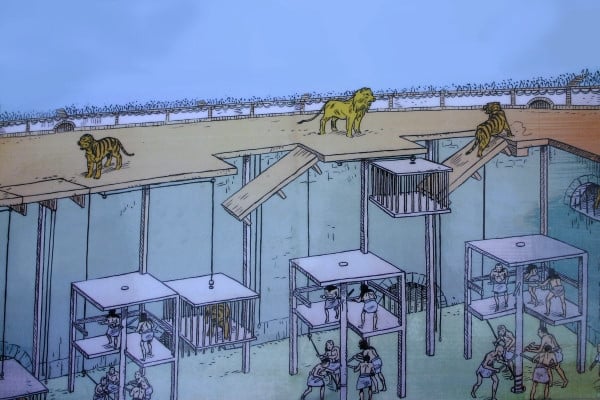
Illustration from a brochure: Colosseum Underground and Third Level.
Some antique sources state that prior to the construction of the hypogea using blocks of tufa and brick, the central area used to be flooded to stage naval battles (naumachiae). This underground area was divided into 15 corridors set to the side of a central gallery along the longest axis of the building (east-west), and were used for the various complex operations of the amphitheatre and hydraulic infrastructure. The stage machinery, armouries games, arms and cages for the animals were all stored here. Hoists operated by capstans served to make figures and sets appear at the centre of the arena through trap doors and ramps, while the animals would enter close to the sides of the arena.
The central gallery continued beneath the eastern entrance towards the Ludus Magnus, the most important training ground for gladiators, the remains of which can still be seen just outside the Colosseum between via Labicana and via di San Giovanni in Laterano. By following this secret passage, the gladiators could reach the arena directly without being seen in the street. The emperors also used a subterranean corridor — called the Passage of Commodus — enabling them to avoid putting themselves at risk by crossing the crowded square in front of the amphitheatre.
Running a great building like the Roman Colosseum needed a large staff and tireless managers to organize them. Some Colosseum staff could be seen by the spectators as they swept and cleaned, guarded the entrances, and lugged heavy safety fences into place. But most people working at the Colosseum were less visible because they worked underground. While the gladiators fought and the lions roared overhead in the arena, dozens of workmen and slaves were busy in the maze of corridors, elevators, stairs, and store-rooms that lay hidden beneath the Roman Colosseum, far from public view.
The Roman engineers designed tunnels to bring the Gladiators into the arena hidden. The animals were confined in cages and raised in elevators 30 feet up. They were trained to assault their enemy at very first sight. Trap doors would launch the animals and men at the same time into the arena. The 4th tier of the arena had the most remarkable technological technology for its times – A retractable roofing made from the canvas was utilized to offer shelter to the audience from the scorching sun.
While the audience in the Colosseum focused on the bloody events in the arena, the hypogeum below it was a scene of furious activity. Laborers performed their backbreaking jobs in humid summer and chilly, damp winter. The chambers reeked from years of accumulated smells of human sweat and wild animals.
It was also dark, lit only by smoky oil lanterns. And it was deafeningly loud, with an overwhelming din of creaking machinery, people shouting, animals growling, and loud signals made by horns or drums to coordinate the complex series of tasks being carried out. Then, when it was all over, there was an eerie calm—but the work was not finished.
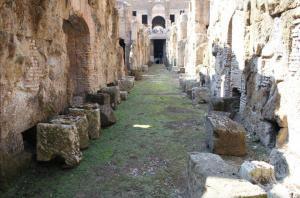
The remains of the underground passages and rooms of the Colosseum. This is where animals and prisoners spent their last hours before being brought into the arena.
Historian Fik Meijer writes, After the spectators have left the Colosseum, a powerful atmosphere of death and decay lingers in the underground passageways. Carcasses of wild animals lie everywhere, along with the corpses of executed criminals, horribly mutilated by the claws and teeth of predators. Everything is drenched in blood and there remains a penetrating odour of rotting esh. But since there may well be another show within a few days, perhaps even the next day, everything has to look clean again. For the large permanent sta of the Colosseum and the extra manpower hired for the occasion, a dispiriting task now begins: clearing out all the corpses and carcasses.
Colosseum Underground Tour: Worth It?
If you are looking for a detailed Colosseum visit and planning to take a tour, we highly recommend you to take a tour that includes visiting the underground of the Colosseum. In the Colosseum Underground Tour, visitors can access special areas (skip the line access) not open to standard entry-ticket holders.
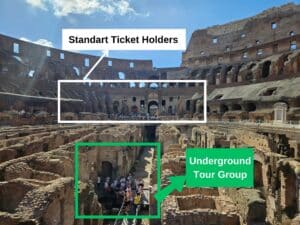
Colosseum Standart Ticket vs Underground Tour
Of course, the first thing you will witness when you visit the Colosseum will be pure stone creations. However standing in the narrow aisles of the Colosseum where gladiators stand before the fights, feeling the atmosphere of the venue, where gladiators were once worried and sweat, is a unique feeling that you must experience. If you think of the Colosseum as a theatre stage, its underground structure called hypogeum is the backstage of the Colosseum. In addition, as you can see in the video below, Italian archaeologists recreated an ancient elevator.

The underground tours of Colosseum usually include the arena section, other parts of the Colosseum (third ring etc.) Roman Forum, and Palatine Hill. You can learn more about how the Colosseum used to be and the lives of gladiators by participating in one of the tours with thousands of positive feedbacks we recommend.
Important: Visiting on a Rainy Day
On days of very heavy rain, the Colosseum underground tours are sometimes canceled. For this reason, it is useful to check the weather forecast before booking a tour.
2023 Update – Good News
The underground structure of the Colosseum can be visited on a tour since 2010. However, these visits covered only a small part of the underground structure of the Colosseum.
As a result of the arrangements and work done by the Italian authorities during the global coronavirus pandemic, tourists will now be able to explore the underground tunnels and rooms almost completely. With the restoration project financed by the Italian fashion company Tod’s and involving 81 archaeologists and experts, 15 corridors were opened to visitors. Visitors will now be able to tour the backstage of the Colosseum, which is spread over half a hectare with a 160-meter walking path, much easier.
Restoring the Colosseum underground is actually part of a much larger restoration project. The project, which is expected to be completed by 2023, is aimed to cover the underground and to be buried in darkness as in ancient times. After the restorations carried out in the arena and underground are completed, visitors to the Colosseum will be able to perceive the functioning of the building much better.
Update: The restoration of the Colosseum underground was completed on 20 July 2023. (Source)
Other Underground Gems in Rome
The city of Rome is often likened to an “archaeological lasagna” – a layered stack of history with each era leaving its mark. Over centuries, structures were built on top of existing ones, with older buildings often filled with earth to form foundations for the next generation of buildings. This has resulted in a wealth of archaeological treasures lying just beneath the surface of the city.
Discovering Rome’s underground sites is like peeling back the layers of time. From the remnants of lavish Roman villas to centuries-old catacombs, these sites provide an intriguing glimpse into the city’s past, and several are open to the public.
Ancient Burial Sites and Catacombs
Vatican Necropolis: The Forgotten City
Often overlooked by visitors, the Vatican Necropolis presents an opportunity to delve into Rome’s bygone era. Hidden beneath St. Peter’s Basilica, this site offers an intimate peek into the ancient city’s burial customs and traditions.
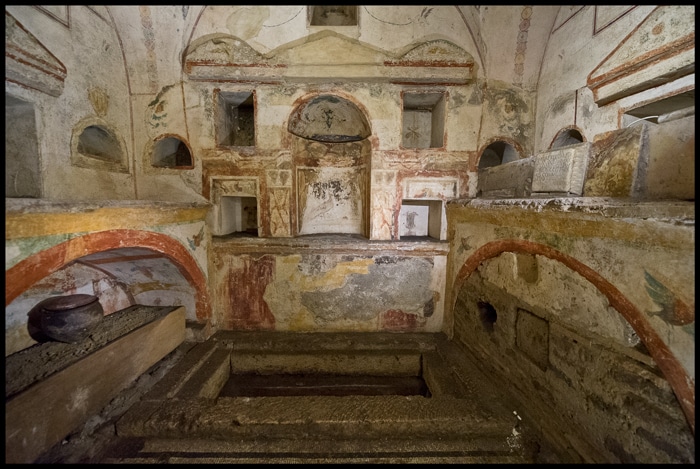
Underground Sites of Rome – Vatican Necropolis. Photographer: Blue 439 via Wikimedia Commons.
Securing a Visit: To book a tour, you must send a request to the Ufficio Scavi. Provide the exact number of tickets needed, preferred tour language, possible dates, names of participants, and contact details. The process requires some forethought, but the reward is a surreal journey through the past.
Guides lead visitors through the basilica’s foundation and the necropolis streets, unveiling painted tombs and narrating the discovery of St. Peter’s tomb. The chance to gaze upon the resting place of St. Peter is a rare opportunity and a memory to cherish.
The Catacombs
The Catacombs of Rome are probably the most well-known underground structures in the city. Spanning over 18 kilometers beneath the city’s surface, these labyrinthine tunnels served as early Christian cemeteries.
The catacombs’ construction began around the 1st century AD, and their use grew more popular as Christianity spread across the empire. The catacombs were expanded vertically and horizontally, eventually accommodating over half a million Christians, including numerous martyrs and popes.
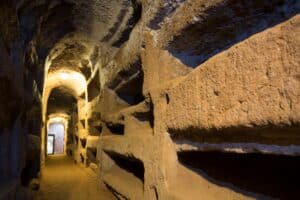
Underground Sites of Rome: St. Callixtus Catacombs
Visiting the catacombs offers a unique glimpse into early Christian life and burial practices. However, bear in mind that access to these sites is strictly regulated and usually requires a guided tour.
from €48.60 EUR
Duration: 3 Hours
Organized by: Walks of Italy
710 Reviews
- Catacombs of S. Callisto: The Catacombs of San Callisto, extending nearly 20 kilometers, is a vast necropolis that served as the final resting place for martyrs and popes. It’s also home to the grave of Saint Cecilia, the patron saint of music.
- Catacombs of S. Domitilla: As Rome’s oldest and best-preserved catacombs, the Catacombs of S. Domitilla feature a 17km network of tunnels, a second-century fresco of The Last Supper, and a fourth-century subterranean church.
- Catacombs of Priscilla: The Catacombs of Priscilla, located near Villa Ada Park, are a labyrinth of tunnels and burial chambers excavated between the second and fifth centuries.
- Catacombs of S. Sebastiano: The Catacombs of S. Sebastiano, used extensively from the first century to inter pagans and Christians, include the martyrs Sebastian and Eutychius.
- Catacombs of St. Agnes: Dispel the myth that catacombs exist only along the Appian Way. Catacombs abound on all roads leading from Rome, one of which is the lesser-known Catacombs of Sant’Agnese, dedicated to the martyred Roman maiden, Agnes. Located conveniently near the S.Agnese/Annibaliano metro station, these catacombs often offer private tours, led by Christian archaeologists. Visitors can explore the basilica adorned with depictions of female saints and visit Santa Costanza, a round church that once served as Constantine’s daughter’s mausoleum.
Historical Religious Sites
The Underground Basilica at Porta Maggiore: A Hidden Sanctuary
Built under the Rome-Cassino railway line, the Underground Basilica at Porta Maggiore is the only known meeting place of the Neo-Pythagorean movement.
Planning Your Tour: Due to its precarious situation under the railway line, the basilica can only be visited on the 2nd and 4th Sundays of the month. Tickets need to be booked through Coopculture well in advance.
San Nicola in Carcere: A Church Built on History
The Church of S. Nicola in Carcere stands over the remains of three Republican-era temples, cells, and alleys. These underground ruins were part of the bustling Forum Boarium complex, ancient Rome’s cattle market.
Santa Cecilia in Trastevere: A Saint’s Abode Below Ground
In Trastevere’s quieter side, the Basilica of Santa Cecilia houses another of Rome’s young female martyrs. A subterranean archaeological area lies beneath, believed to be the saint’s residence.
The underground space, although impressive, can be puzzling without proper information. However, the cosmatesque-style crypt housing St. Cecilia’s relics at the end of the tour is a sight to behold.
The Basilica of San Clemente
Often overshadowed by the nearby Colosseum, the Basilica of San Clemente is a three-tiered architectural marvel that deserves your attention.
Beneath the 11th-century Basilica, you’ll discover a 4th-century clandestine room, once a hub for early Christian worshippers. Dive further, and a 3rd-century Mitharic sanctuary awaits, where ancient rituals of the Persian-origin mystery cult took place.
Planning your visit: Opening Hours: Mon-Sat: 10am-12.30pm & 3pm-5.30pm; Sun 12pm-5.30pm. Entry fee: €10, reduced €5.
Architectural Marvels and Ancient Houses
Roman Houses on the Celio Hill: A Walk Through History
The Roman Houses on the Celio Hill, under the church of Peter and Paul, offer a unique opportunity to experience Rome’s ancient lifestyle. As you navigate between the different houses, you traverse four centuries of history.
Vicus Caprarius: A Peek into Rome’s Layered History
Situated near the Trevi Fountain, Vicus Caprarius offers a year-round viewing of Rome’s ancient domus and the castellum aquae, reservoir constructions for the nearby aqueduct.
Arranging a Guide: To enhance your experience, consider arranging a guided tour with Archecodomani, the organization responsible for the site. Although not as grand as the Colosseum, Vicus Caprarius provides a unique understanding of Rome’s development over time.
from €35.00 EUR
Duration: 40 Min.
Organized by: Touriks
573 Reviews
Palazzo Valentini: A Light Show of Ancient Rome
Underneath Palazzo Valentini remain the traces of ancient Roman houses. The highlights of the tour are the light projections that trace the structures’ original layout, offering a vivid imagination of life in ancient Rome.
Remnants of Ancient Public Life
Stadium of Domitian
The Stadium of Domitian, now a fascinating underground treasure in Rome, was originally built in the 1st century AD by Emperor Domitian. Primarily used for athletic contests, it was Rome’s first permanent venue for competitive games distinct from the Circus Maximus, which was more focused on chariot races. Unlike the larger Colosseum, the Stadium of Domitian was specifically designed for track and field events.
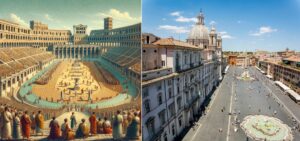
Five meters beneath Piazza Navona, you’ll encounter the remnants of the Domitian Stadium, a UNESCO World Heritage Site. This masonry athletics stadium is unique in Roman history.
Over time, the stadium was largely forgotten and built over, leading to its current status as an underground marvel. Today, it lies beneath the Piazza Navona, one of Rome’s famous public squares, revealing a captivating glimpse into ancient Roman life and architecture. Its subterranean remains are a testament to Rome’s layered history, offering a unique perspective on the city’s past as a bustling center of athletic competition and public gatherings.
Planning Your Visit: Opening Hours: Saturday, 10am-7pm; Entry fee: €7-9
from €9.00 EUR
Validity: 1 Day
Seller: Tiqets
197 Reviews
The Baths of Caracalla: Rome’s Largest Baths
Beneath Rome’s largest baths lies a complex network of tunnels, once used to heat and service the baths. The highlight of the tour is one of Rome’s surviving Mithraeums, temples dedicated to the Eastern god Mithra.
from €18.50 EUR
Seller: Tiqets
212 Reviews
Scheduling Your Visit: You can book your tickets in advance through the Coopculture website. The summer evening tours offer a captivating exploration of the baths and the Mithraeum.
Unique Discoveries and Exhibits
Crypta Balbi
Part of the National Museum of Rome, Crypta Balbi provides a comprehensive overview of Rome’s urban development over time. The site features remnants of an ancient theater and a colonnade, among other structures, and has served various functions over the centuries, from a burial ground and quarry to a bathhouse and a convent.
Nero’s Golden House: A Monumental Pleasure Palace
Lastly, no tour of Underground Sites of Rome is complete without visiting Nero’s Golden House. The underground tour covers a small part of the once massive pleasure palace. The virtual reality reconstruction provides a glimpse into the palace and its landscape during Nero’s reign.
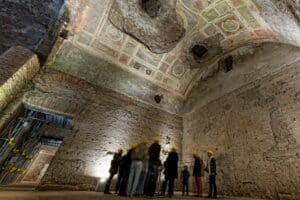
Nero’s Golden House – Domus Aurea. Photographer: Andrea Izzotti
Rome’s vast history seeps into the city’s soil, with countless tales waiting to be unearthed. Exploring these Underground Sites of Rome, you can appreciate the city’s historical depth and marvel at its timeless allure.

